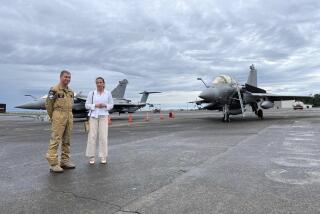U.S. Reneging on Aid Pledge, Manila Charges
- Share via
MANILA — In the most contentious meeting of his tour of Asian capitals, Defense Secretary Dick Cheney on Monday faced an angry Philippine Defense Secretary Fidel V. Ramos, who accused the Bush Administration of reneging on pledges of military and economic aid.
Cheney said at a press conference that the United States “would like to do more” to assist the Philippines but that the U.S. Congress is unlikely to restore a $96-million cut in pledged payment for use of six U.S. military facilities in the country.
“The budget situation is such that we’re undergoing significant reductions,” Cheney said. An aide said later that Cheney gave Ramos a “realistic” appraisal of competing foreign aid demands on Congress during their three-hour meeting.
Anti-U.S. demonstrators protesting Cheney’s visit clashed with police near several U.S. installations, and one band of protesters burned the defense secretary in effigy.
In 1988, then-Secretary of State George P. Shultz agreed that the White House would make its “best effort” to pay $481 million a year, for two years, for use of the military bases. The Bush Administration followed through on the pledge, but Congress reduced the request by the $96 million.
Partly as a result, Cheney’s 24-hour visit here comes as relations between the United States and its former colony are increasingly strained. Last week, President Corazon Aquino abruptly canceled a planned meeting with Cheney, citing the aid cut and what she called distorted press reports of her recent meetings with U.S. officials. The cancellation was widely perceived here as a snub.
At his press conference, Cheney denied reports in the Philippine press that the cutbacks signal reduced U.S. support for the Aquino government. He noted that the Philippines remains the fifth-largest recipient of U.S. foreign aid.
“I think that is a misreading of events to suggest that somehow the United States is trying to send signals other than the one I have already given publicly, which is our very strong commitment to our alliance with the Philippines,” he said.
The bases have long been a contentious issue here. Politicians on the left, as well as Communist insurgents, have generally demanded that the United States leave them. Those on the right, including followers of the late President Ferdinand E. Marcos, usually demand increased U.S. payments. Now, the $96-million cut has brought the traditional political foes together in anger.
About 50 demonstrators picketed and burned an effigy of Cheney outside the heavily guarded Camp Aguinaldo military headquarters in suburban Quezon City, where the Pentagon chief met Ramos. The protesters carried banners reading, “Cheney Warmonger, Go Home,” and “White Monkey, Go Home With Your Bases.”
No violence was reported near Subic Bay Naval Base, a major U.S. installation west of Manila that Cheney visited later in the day. But about 300 student protesters clashed with police trying to stop them from dismantling barbed-wire barricades at the entrance to U.S.-operated Clark Air Base, 50 miles north of the capital.
Participants said that about 30 students were injured. The protesters regrouped later to stage what they called an “indignation rally,” accusing Philippine police of being “puppets of U.S. imperialism.”
In Manila, another 100 or more student protesters, chanting “Yankees go home,” skirmished at the U.S. Embassy with police, who waved clubs and fired tear gas to disperse them. One student was arrested and four police officers were reported hurt.
Talks are expected to begin this spring on U.S. proposals to extend leases for the bases, which expire in September, 1991. Cheney said the United States wants to continue to base naval and air forces in the Philippines but indicated that it is increasingly limited in its ability to pay for foreign bases.
“The United States will stay only as long as the Philippine people and the government want us to stay and only under conditions that are acceptable to both parties,” Cheney said. He left no doubt that the United States is willing to abandon the bases if Philippine demands for additional money are not moderated.
But a senior Pentagon aide said he was “surprised by the vehemence” of Ramos’ insistence that the U.S. fulfill its earlier pledges of aid. He speculated that the Aquino government is seeking a way to distance itself publicly from Washington.
Aquino’s political opponents have accused her of being beholden to the United States after American jet fighters were scrambled from Clark Air Base to help put down an attempted military coup against her government last December. The attempted coup was the sixth since she came to power in 1986.
Cheney left for Japan early today, the last stop on his four-nation tour.
BACKGROUND
Under a Military Bases Agreement signed in 1947, the United States maintains and operates major facilities on two Philippine bases, Clark Air Base and Subic Naval Base, and several small subsidiary installations. About 15,300 U.S. military personnel are stationed in the country (not counting 7th Fleet personnel temporarily ashore), together with nearly 1,000 defense civilians and about 24,000 military dependents. The agreement was amended in 1979 to give full recognition of Philippine sovereignty over the bases, provide for Philippine command of all bases and return substantial areas to Philippine military control.
More to Read
Sign up for Essential California
The most important California stories and recommendations in your inbox every morning.
You may occasionally receive promotional content from the Los Angeles Times.














